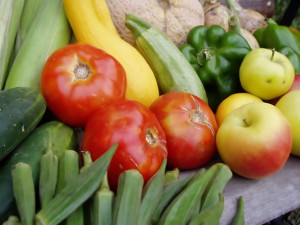
You may have been reading about fermented vegetables and how great they can be for your body. One thing to remember is they need to be a part of your diet every day, but let me tell you it can get old just eating some sauerkraut everyday. So I wanted to share some ways we get these great foods into our daily menu.
First, keep in mind eating just one kind of fermented food closes off the benefits that other fermented vegetables have to offer. You need a variety to provide the full range of nutrients different vegetables have to offer. Look beyond just sauerkraut.
1 As a Side or Topping
This is an easy one. As we all know you could put some sauerkraut on the plate beside the main serving. But how about putting the side on the main dish. Sauerkraut works wonders as a topping on meats. On chicken it helps to bring out the taste in the chicken, while the chicken takes the sour edge off the sauerkraut. An added bonus is that the fermented vegetable contains wonderful enzymes that help to break down the meat proteins during digestion.
There are many other fermented foods that work great to complement foods. What about something simple like ketchup on eggs. Make up some fermented ketchup and you have another great topping and don’t forget those enzymes help digest the proteins in the eggs, Great!
2 On Green Salads
Most vegetables can be fermented and since these are still considered raw, (Raw vs. Cooked vs. Fermented Vegetables, The Winner?), they make great additions to salads. Just ferment up your favorite vegetables, carrots, peppers, sauerkraut, beets, onions, etc. Pick the ones you like. Since fermented vegetables can still be crunchy they can add some needed difference to many salads.
These fermented foods do aid in the digestion of proteins in salads such as meats, and beans. And these great digestive enzymes don’t have a problem helping out with the digestion of other unfermented raw vegetables.
The Original Veggie Fermenter (starter kit).
Just add the food and a jar
3 In Smooties
Just as you may add spinach to smoothies, fermented vegetables can be added too. Just don’t add a lot of vegetables since these can be bitter. Homemade yogurt makes a great base for a smoothie and it is a fermented food too. Yogurt can give lots of the foundational probiotics we need in our diet.
4 Left Over Brines/Juices
Use that left over vegetable brine that is packed with great taste and probiotics to help flavor soups and sauces. Just keep in mind that these items need to be added at the end of the cooking stage so you are past the high tempeture and there is less of a chance to kill all the beneficial bacterial. Spaghetti sauce can be given a neat extra taste.
5 In a Wrap or Sandwich
Sauerkraut works wonders for taste on a meat sandwich, and wraps can be given a crunchy aspect by adding fermented vegetables like carrots, peppers, etc. And don’t stop there, burgers off the grill are the perfect match for fermented vegetables and condiments.
Make Fermented Food At Home – Easily
6 Dips
Chips work great with fermented salsas. You can also add the fermented vegetables to guacamole, sour cream dips, and hummus. Hummus itself can be fermented. Wow, lots of possibilities.
My kids use 7 carrots as dipping sticks when eating dips.
7 Condiments
Yup, most condiments can be fermented. Ketchup, mayo, mustard, onions, garlic, peppers, relishes and chutneys, are all items that work great in fermented versions. And often these condiments last when kept in the fridge so they are ready when needed.



Speak Your Mind